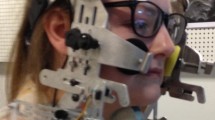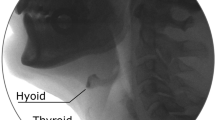Abstract
Little data exist on the oral management of food boluses in neurologically normal children or children with cerebral palsy (CP). Twenty children with spastic CP and 20 neurologically normal children (age range: 6.2–12.9 years) were monitored with ultrasound imaging of the oral cavity during liquid and solid bolus tasks. A lip-cup contact detector synchronized to ultrasound image output was used during liquid tasks. Data collected from recorded ultrasound images were used to assess durational aspects of the oral phase of swallowing in neurologically normal children and children with CP. Coordinated analysis of ultrasound images with lip-cup contact data allowed timing of intervals in the pre-oral and oral phases of swallowing during liquid feeding tasks. Children with CP required more time than neurologically normal children for collection, preparation, oral transit, and total oral swallow time for 5-ml liquid boluses. Total oral swallow time was longer for solid bolus tasks in children with CP. Oral transit time for solid boluses was significantly longer than for liquid boluses in neurologically normal children and children with CP.
Similar content being viewed by others
References
Freeman, JM, Nelson, KB: Asphyxia and cerebral palsy. Pediatrics 82:240–249, 1988
Stallings, VA, Charney, EB, Davies, JC, Cronk, CE: Nutritionrelated growth failure of children with quadriplegic cerebral palsy. Dev Med Child Neurol 35:126–138, 1993
Mueller H: Feeding. Handling the Young Cerebral Palsied Child at Home. London: William Heinemann Medical Books Ltd, 1974, pp 111–130
Helfrich-Miller KR, Rector KL, Straka JA: Dysphagia: its treatment in the profoundly retarded cerebral palsied patient. Arch Phys Med Rehab 67:520–525, 1986
Griggs C, Jones P, Lee R: Videofluoroscopic investigation of children with multiple handicaps. Dev Med Child Neurol 31:303–308, 1989
Casas M, McPherson K, Kenny D: Swallowing/ventilation interactions during oral swallow in normal children and children with cerebral palsy. Dysphagia 9:40–46, 1994
Shawker TH, Sonies B, Stone M, Baum BJ: Real-time ultrasound visualization of tongue movement during swallowing. J Clin Ultrasound 11:485–490, 1983
Shawker TH, Sonies B, Hall TE, Baum BF: Ultrasound analysis of tongue, hyoid and larynx activity during swallowing. Invest Radiol 19:82–86, 1984
Smith WL, Erenberg A, Nowak A, Franken EA: Physiology of sucking in the normal term infant using real-time US. Radiology 156:379–381, 1985
Stone M, Shawker TH: An ultrasound examination of tongue movement during swallowing. Dysphagia 1:78–83, 1986
Weber F, Woolridge MW, Baum JD: An ultrasonographic study of the organization of sucking and swallowing by newborn infants. Dev Med Child Neurol 28:19–24, 1986
Sonies B, Parent L, Morrish K, Baum B: Durational aspects of the oral-pharyngeal phase of swallow in normal adults. Dysphagia 3:1–10, 1988
Bosma JF, Hepburn LG, Josell SD, Baker K: Ultrasound demonstration of tongue motions during suckle feeding. Dev Med Child Neurol 23:223–229, 1990
Wein B, Böcler R, Klajman S: Temporal reconstruction of sonographic imaging of disturbed tongue movements. Dysphagia 6:135–139, 1991
Casas MJ: Ultrasound investigation of ventilation/swallowing interactions during the oral phase of swallow. Thesis, Toronto: University of Toronto, 1992
Kenny DJ, Casas MJ, McPherson KA: Correlation of ultrasound imaging of oral swallow with ventilatory alterations in cerebral palsied and normal children: preliminary observations. Dysphagia 4:112–117, 1989
Curtis DJ, Cruess DF, Dachman AH, Maso E: Timing in the normal pharyngeal swallow: prospective selection and evaluation of 16 normal asymptomatic patients. Invest Radiol 19:523–529, 1984
Woods GE: The handicapped child. Assessment and management. Cerebral palsy—Types of Movement Defect. Oxford: Blackwell Scientific Publications, 1975, pp 108–138
Blair E, Stanley F: Interobserver agreement in the classification of cerebral palsy. Dev Med Child Neurol 27:615–622, 1985
McPherson KA, Kenny DJ, Koheil RM, Bablich K, Sochaniwskjy AE, Milner M: Ventilation/swallowing interactions of normal children and children with cerebral palsy. Dev Med Child Neurol 34:577–588, 1992
Patrick J, Boland M, Stoski D, Murray GE: Rapid correction of wasting in children with cerebral palsy. Dev Med Child Neurol 28:734–739, 1986
Dubner R, Sessle BJ, Storey AT: The Neural Basis of Oral and Facial Function. New York: Plenum Press, 1978, pp 359–360
Dantas R, Dodds W, Massey B, Kern M: The effect of high-vs low-density barium preparations on the quantitiative features of swallowing. AJR 153:1191–1195, 1989
Author information
Authors and Affiliations
Rights and permissions
About this article
Cite this article
Casas, M.J., McPherson, K.A. & Kenny, D.J. Durational aspects of oral swallow in neurologically normal children and children with cerebral palsy: An ultrasound investigation. Dysphagia 10, 155–159 (1995). https://doi.org/10.1007/BF00260969
Issue Date:
DOI: https://doi.org/10.1007/BF00260969




